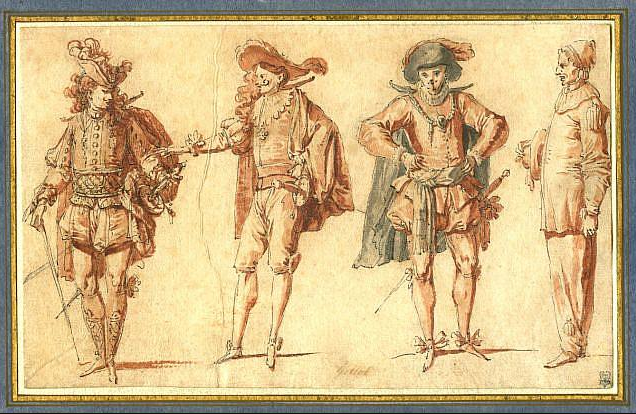March 2020
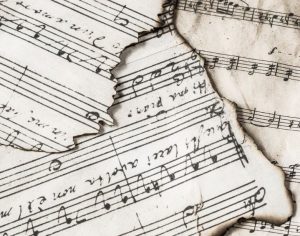 For me to write a blogpost about serialist music — serialist, twelve-tone, call it what you will — is both cheeky and astonishing. The cheek comes from the fact that although I’m quite handy with a score and know how to dance the interpretation minuet, that all falls apart for music written after about the year 1800. Ask me what to do with the many ornamentation signs in the work of Couperin and I can bend your ear for a good while. Put me in front of a score by Schoenberg, however, and I’ll start to splutter fairly quickly. I am not to that manor born nor do I have any relatives there.
For me to write a blogpost about serialist music — serialist, twelve-tone, call it what you will — is both cheeky and astonishing. The cheek comes from the fact that although I’m quite handy with a score and know how to dance the interpretation minuet, that all falls apart for music written after about the year 1800. Ask me what to do with the many ornamentation signs in the work of Couperin and I can bend your ear for a good while. Put me in front of a score by Schoenberg, however, and I’ll start to splutter fairly quickly. I am not to that manor born nor do I have any relatives there.
The astonishing bit comes from the fact that I, Baroque maven that I am, absolutely love the music of Schoenberg and his disciple Leibowitz in their hardest-core serialist manifestations. I’m at something of a loss to explain that predilection. As Pascal so famously said, “Le coeur a ses raisons, que la raison ne connaît point.” The heart has its reasons of which reason knows nothing. That’s a fairly cheap cop-out for just saying “I like it” and leaving the reasons to float about in La La Land. The only thing that comes to my mind as a possible hook is appreciation for the tight structure of serialist music. I’m used to tight musical structures from the Baroque period, so maybe my brain just perceives the extremely rationalist structure of twelve-tone music and feels at home. That seems rather grasping at straws, though, I must say. There’s nothing about the sound or affect of a twelve-tone piece that remotely resembles Baroque music. I must love it for other reasons currently beyond my ability to identify. But love it I do, there’s no question of that. I’ve loved Schoenberg’s Pierrot Lunaire from the first time I heard it lo these many decades ago. Many years ago I bought a CD of music by Rene Leibowitz after I read that he was a devotee of Schoenberg and championed the serialist approach throughout his career. I’d never heard of the man before and had no idea what his music was like, but the Schoenberg connection was enough to make me buy the CD. I’m glad I did. It’s pure serialism and as intriguing to me as the work of the master Schoenberg himself.
The two composers are very different in what could be called their composition context, however. Schoenberg took his time arriving at the serialist doorstep. For Leibowitz serialism was a point of musical conviction from which he never departed. Schoenberg’s Pierrot Lunaire, composed in 1912, is after many years still my favorite of his works but it’s not strictly serialist. It’s atonal, yes, but not twelve-tone. To keep our categories straight here’s the skinny on twelve-tone serialism from its Wikipedia page (here):
The twelve-tone technique—also known as dodecaphony, twelve-tone serialism, and (in British usage) twelve-note composition—is a method of musical composition first devised by Austrian composer Josef Matthias Hauer, who published his “law of the twelve tones” in 1919. In 1923, Arnold Schoenberg (1874–1951) developed his own, better-known version of 12-tone technique, which became associated with the “Second Viennese School” composers, who were the primary users of the technique in the first decades of its existence. The technique is a means of ensuring that all 12 notes of the chromatic scale are sounded as often as one another in a piece of music while preventing the emphasis of any one note through the use of tone rows, orderings of the 12 pitch classes. All 12 notes are thus given more or less equal importance, and the music avoids being in a key. Over time, the technique increased greatly in popularity and eventually became widely influential on 20th-century composers. Many important composers who had originally not subscribed to or even actively opposed the technique, such as Aaron Copland and Igor Stravinsky, eventually adopted it in their music.
I find it interesting to speculate about the underpinnings of Schoenberg’s development away from tonality. Already in 1912 with Pierrot Lunaire he abandoned the framework of composition inherited from the 19th century and dispensed with focus on a tonal structure. Consider for a moment works by other composers contemporaneous with Schoenberg in 1912 — for example, Richard Strauss, who pulled tonality six ways to Sunday but never ditched it wholesale. In 1911 out came Der Rosenkavalier with the Marschallin and those bazooms (one thinks particularly of Kiri Te Kanawa’s performance in the role, she fairly falls out of the posh frock on numerous occasions). It’s still all about boy-meets-girl and bazooms and hoity-toities having their feelings blah blah blah — you know the story, it’s been told a bazillion times before. And while that fraught business was being transacted on opera stages throughout Europe, out comes Pierrot Lunaire. Knock me over with a feather.
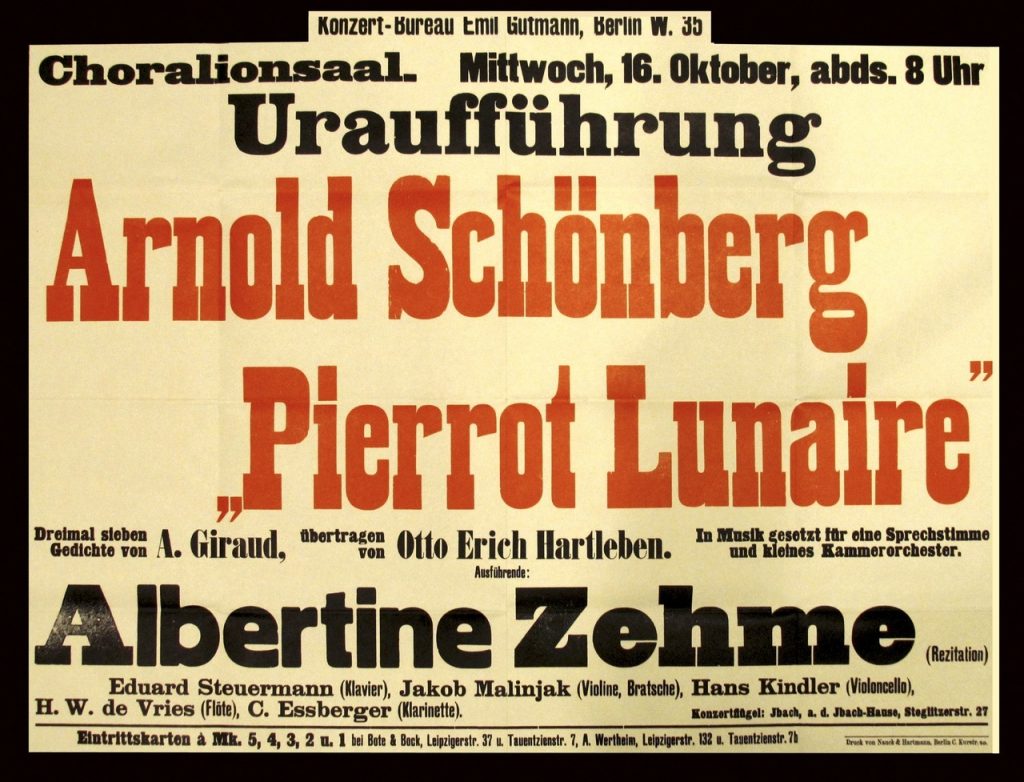
To a less than robustly trained ear like mine the atonality of 1912 is scarcely distinguishable from the full twelve-tone technique Schoenberg developed in 1923 and used thereafter. Setting aside for the moment the purely structural aspects of his compositions from the two periods, what motivational thread can we distinguish between them? I see one, indeed I do. As a complete outsider I feel no compunction to keep my mouth shut lest somebody call foul on me, so I’ll spill the beans.
Pierrot Lunaire is prescient not only musically but sociologically, as well. 1912 was a time when the death rattles of the Belle Epoque were audible to those with ears to hear. Der Rosenkavalier continued the trance of High Romanticism — all lovely enough on its own terms, let me not be accused of Schadenfreude, but it nonetheless represents the terminus of the phenomenon. In a few short years World War I will break out and deal a death blow to the Belle Epoque. The world will never be the same again — just ask the aristocracy of Edwardian England when things went off the rails and when the lives they had cultivated for centuries finally bit the dust. Their answer will be, “It was the war …” But even before the outbreak of war it was clear that things weren’t going too well.
It’s fitting that the warning shots across the bow should have come from Austria, since Austria was one of the places with the worst rot in the floorboards. Think of the putrefying carcass of the Habsburg Empire and all the evils that festered in it over the course of the 19th century. The mind fairly reels at their scope. It was abundantly clear to anyone at all perspicacious that things couldn’t possibly end well. There was no regenerative spirit at work anywhere in the whole sorry, sodden business. It all lumbered along in a downward spiral that was bound to end badly — which is, of course, exactly what happened.
So while Strauss was attempting to breathe new life into the tropes of the Belle Epoque with the Marschallin and her bazooms, Schoenberg with Pierrot Lunaire takes another cultural trope and thoroughly deconstructs it. The poetry used for the composition was reworked from Albert Giraud’s original French into German by Otto Erich Hartleben. The reworking itself says much about the nature of Schoenberg’s music. Let’s have a look at what happened in translation. The first poem of the set will serve well as an example (you can watch an appropriately eerie performance of it by Christine Schäfer on YouTube here):
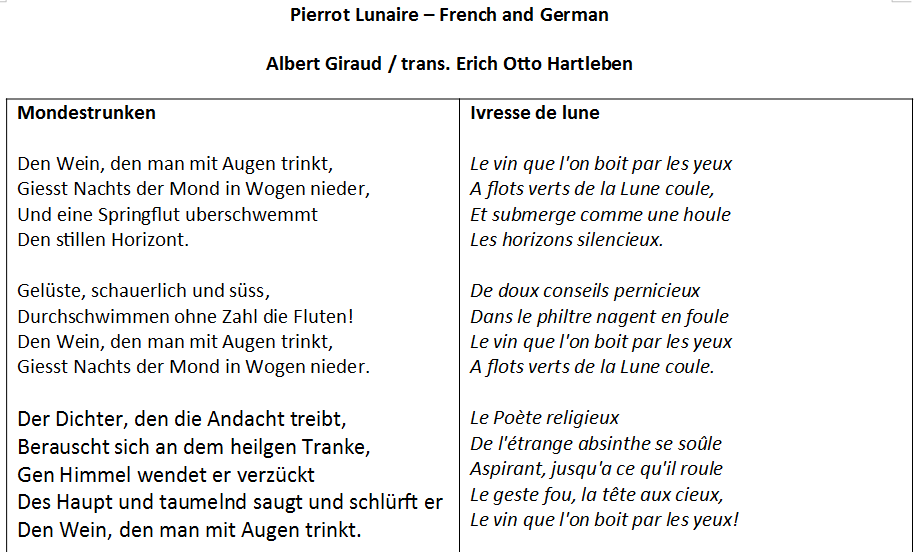
We’re dealing a cultural trope that goes back all the way to the Renaissance — the Italian commedia dell’arte, which is essentially social satire designed to produce guffaws. In Giraud’s French original the satire becomes reflexive and the observational point of view becomes ironic — we are on the outside looking in on the character of Pierrot, the clown, to observe his eccentricities, indeed his madness. Giraud’s Symbolist verse retains something of the flippancy and lightheartedness of the commedia dell’arte. It’s all very stylized and self-consciously ironic — it’s Giraud taking the mickey out of the comic clown figure and giving him a Symbolist twist with absinthe (purported to cause madness) that comes from the moon.
In his “translation” Hartleben shifts both the linguistic register and the nature of the imagery. Giraud’s imagery is squarely physical, the wine being related both by name and by reference to color to absinthe, booze that was all the rage in the Belle Epoque. Hartleben abstracts the “wine” away from anything physically identifiable and makes it into a mysterious psychic force. The words Hartleben uses have a much heavier undertow than those of Giraud. Translating poetry from one language to another is always a fraught business due to the impossibility of matching exactly the semantic envelopes of words in both languages. But Hartleben has dispensed with any attempt at equivalence and uses the French original as no more than a springboard for the creation of text that IMHO bears very little relation to the original with regard to the felt sense of the words.
In the second strophe, for example, Girauds “De doux conseils pernicieux” has something ironic and amusingly naughty about it. It has the air of Baudelaire, the fusion of opposites into a turgid and charged experience that always remains elegant and quintessentially aesthetic despite ist being outré. It strikes me as something some Belle Epoque babes might whisper to one another at a costume ball. Hartleben’s “translation” is much darker and much more twisted. The semantic envelope of the word “schauerlich” is completely different from the French word “pernicieux,” which has an analogue in English with a similar envelope. “Schauerlich” is grisly, gnarly, gruesome. The word pertains to something at once nasty and spooky, not delightfully naughty. To couple such a word with süß — “sweet” without the non-literal envelope of “pleasant” the French word “doux” carries — is to turn the psychology involved into something resembling the BDSM trope of something that “hurts so good.” That’s a Teutonic spin on the basic item if ever there was one, is it not?
In point of fact the linguistic undertow Hartleben has infused into his “translation” makes my hair stand on end. It’s not a witty, pretty bit of irony like Giraud has set before us — it’s the darkness that will erupt into war in 1914 and wreak untold horrors, just as it has erupted so often in the course of human history. And this darkness, so Hartleben tells us, is not a “conseil” (=”tip”) as it is for Giraud, it is a Gelüst, a craving, something that seizes you and compels your behavior outside rationality. So Pierrot goes from Giraud’s buffoon knocking back a few and getting amusingly bladdered to Hartleben’s celebrant in a scene with all the hallmarks of a witches’ sabbath and with ominous darkness spreading out in all directions like blood from a stab wound.
Yikes.
But how beautifully appropriate for the year 1912. The rot in the Belle Epoque was too far gone and the stink from its putrefaction already too thick in the air to pretend any longer than things were going to carry on pleasantly. It was already clear to many — obviously to Schoenberg — that the whole business was set to come apart at the seams in some wholesale disaster. That historical irony seems to me the defining psychology of the piece — perhaps unconsciously in Hartleben’s “translation” but with full consciousness in Schoenberg’s music. The ha-ha of the commedia dell’arte becomes a stare into the abyss of what is about to happen when the whole shebang goes off the rails. Darkness breaks out in all directions. Rationality goes out the window. And while all this happens, a highly focused and observant consciousness stuck in the middle of the muddle knows exactly what’s going on and points it out to our attention if we but have eyes to see and ears to hear.
Visually the premier of Pierrot Lunaire was about as far from the claptrap of Grand Opera as you could get. The work was commissioned by Albertine Zehme, a former actress, who appeared on stage with a skeletal instrumental ensemble (flute, clarinet, violin, cello, and piano) dressed as Colombina of the commedia dell’arte. No 101 Violins swelling in great crescendos of turgid emotion. No posh frocks and no importance whatever placed on bazooms. Fancy that.
Of course things did fall apart quite spectacularly in 1914. It makes sense to me that Schoenberg would arrive at his formal serialism only in the 1920’s after the war — after all, when there’s a war going on it’s quite a trick to pull new compositional techniques out of the hat. There are more important things to attend to, like finding enough to eat. Schoenberg’s adoption of formal serialism in 1923 makes perfect sense to me, however — it’s the logical sequence to what he was doing in 1912. With the war behind him and the world order of the Belle Epoque destroyed forever, it was high time to come up with something cut from new cloth in the matter of musical composition.
Bear in mind that Schoenberg knew classical composition techniques backward and foward. It behooves us to remember that he wrote a textbook on classical counterpoint to use in his own classes. So the launch of twelve-tone technique springs from Schoenberg’s mastery of the traditions of classical composition. All those classical techniques were at his fingertips yet he felt compelled to create something entirely new. Why?
I find in Schoenberg’s serialism a continuity with the thread we picked up in 1912 with Pierrot Lunaire. The world had changed forever and there was no going back to what had existed before 1914. It makes perfect sense to me that Schoenberg would find it meet and right to create a compositional technique suited to the new world he inhabited. How to capture and express musical thought realistically after World War I with 101 violins and crescendos of emotion? No, it required something entirely different. So Schoenberg set about creating a new vehicle for the expression of musical thought and sensibility. After the complete discombobulation of rationality and sensibility between 1914 and 1918, it also makes sense to me that the rationality of serialism should be the musical equivalent of quantum mechanics. What better basis for music than the exigencies and elegance of physics? It’s the equivalent of making quarks sing if you consider it in that regard. From that perspective it makes all the sense in the world.
Which brings us to Schoenberg’s Suite for Piano op. 25, completed in 1923. You can hear it on YouTube here. It’s another instance of cultural irony that Schoenberg’s essay in twelve-tone technique takes the form of a Baroque suite. The movements are:
- Präludium
- Gavotte
- Musette
- Intermezzo
- Menuett
- Gigue
With the exception of the Intermezzo (a 19th century form and a favorite of Brahms) we could be looking at a keyboard suite of the 18th century from either Germany or France. The irony operates in the complete disconnect between the traditional dance form titles and the content. What Handel or Bach would make of it one scarcely likes to think. So why is it then that when I hear the Musette I am entranced? As a matter of fact, it calls to mind the piano part of the first piece in Pierrot Lunaire. Have a look and see what you think:

_______________________________________________________________________
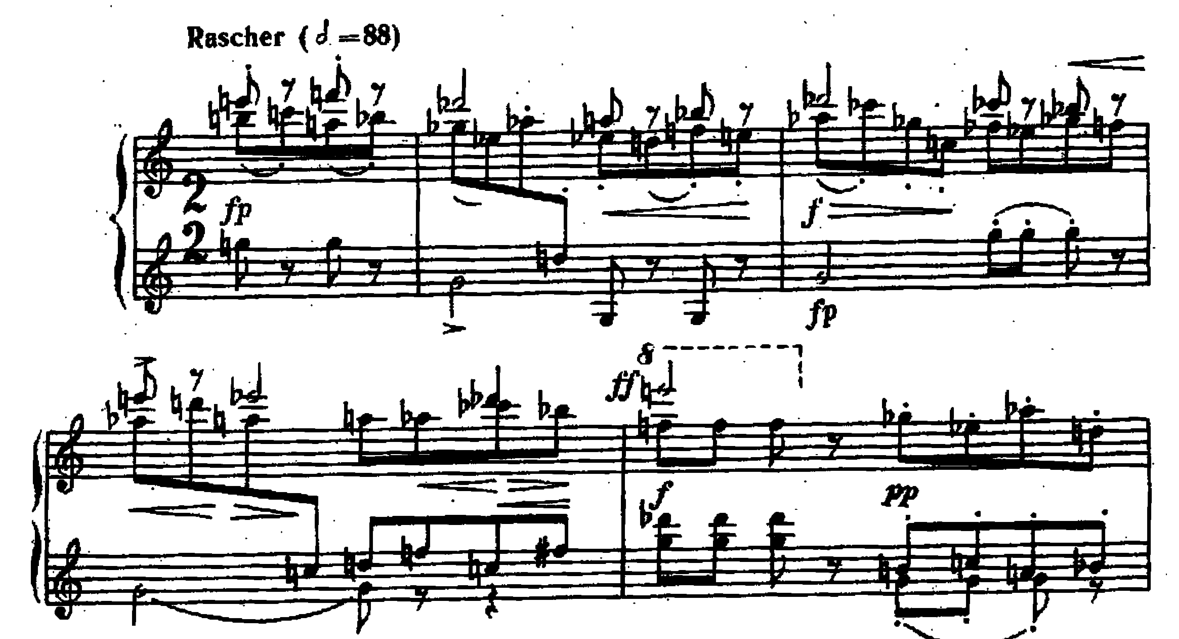
From the standpoint of complexity it rivals any fugue with multiple soggetti I can imagine. And yet it’s delicate and pointilliste, like the sound you can imagine coming from Sèvres porcelain. Clearly, the thread from 1912 to 1923 is not just in my imagination. There are continuities of style, technique and sensibility involved. I suppose one could, if one were in a bad mood and had a tin ear, be induced to say that if you’ve heard one atonal piece you’ve heard them all. To such an utterance I could only answer, “They feel completely different from each other.” Here we find ourselves in that vast zone where music and language pass each other by like the proverbial ships in the night. I can’t articulate completely what it is about the Musette of the op. 25 Suite that differentiates it from the piano music written for Pierrot Lunaire. I can only say that IMHO it expresses a completely different sensibility and springs from other wells of inspiration. It creates a completely different emotional effect — one almost impersonal, as though one happened upon some natural phenomenon that produces sound, like the gurgling of a fountain or the sound water makes falling across stones in a brook. It’s lovely but I don’t quite know exactly how.
And so we come to René Leibowitz. Quite the character. Here’s some biographical info from his Wikipedia page (here):
The facts about Leibowitz’s early years are problematical, complicated by his practice of reinventing his history, but it is known that he was born in Warsaw, Poland. According to his pupil and translator, Jan Maguire, who wrote two studies of him for Tempo magazine in the late 1970s, Leibowitz was of Russian Jewish parentage; his father was an art historian. During the First World War the family was obliged to move from Warsaw to Berlin, where, Maguire writes, Leibowitz began a career as a concert violinist at the age of ten. That career was interrupted when the family moved to Paris three years later. By Maguire’s account Leibowitz taught himself “the fundamentals of harmony, counterpoint and score-reading” while in high school, and took his Baccalauréat when he was seventeen. At this point, his history becomes unclear. By his own account, credited by Maguire and others, he then went to Vienna to study with Anton Webern. By other accounts he studied with Arnold Schoenberg. Neither is now believed to be correct: Sabine Meine wrote in the Grove Dictionary of Music and Musicians in 2001, “Leibowitz’s claims of having met Schoenberg and studied with Webern in the early 1930s remain unsubstantiated”, and in 2012 Nicole Gagné wrote in the Historical Dictionary of Modern and Contemporary Classical Music, “despite his claims to the contrary, he never studied with Arnold Schoenberg or Anton Webern”. Other claims about Leibowitz’s teachers – that he studied composition with Maurice Ravel and conducting with Pierre Monteux – have been discounted by some writers in the present century, although as recently as 2010 in a study mainly focused on American composers Deborah Fillerup Weagel repeated the statement that Leibowitz was a pupil of Webern and Ravel. There is no mention of Leibowitz in the biographies of Ravel by Arbie Orenstein (1991) and Roger Nichols (2011) or of Monteux by John Canarina (2003).
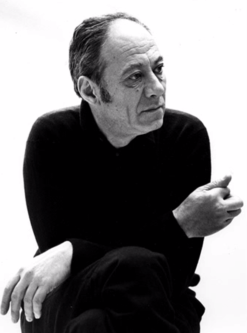
A bit dodgy, to say the least. Leibowitz’s reputation has not survived into the 21st century, he’s as obscure as can be these days. I take Leibowitz seriously more because of his connection with Theodor Adorno than due to his (apparently trumped-up) association with Schoenberg. Adorno, quite apart from being a powerhouse of critical theory in the Frankfurt School, was himself a composer and music critic. In a letter he wrote to Leibowitz in 1948 Adorno waxes almost rhapsodic in his praise:
“Es ist kein Zweifel daran, daß Ihre Stücke das höchste Kompositionsniveau repräsentieren, das heute überhaupt gefunden werden kann — von einer Reinheit, Unbestechlichkeit und Konzessionslosigkeit, und zugleich einer so vollkommenen Verfügung über die Mittel in allen ihren Dimensionen, daß man Ihre Stücke allem, was heute zu komponieren sich unterfängt, als ein verpflichtendes Paradigma vorhalten möchte.”
[There is no doubt that your works represent the highest level of composition to be found today — showing a purity, an integrity and uncompromising quality and at the same time so complete a mastery of all musical means in all their dimensions, that one would like to hold your works up as an obligatory paradigm for all who undertake to compose.]
Actually that’s more than two thumbs up from a critic who never hesitated to bitch slap anybody who failed to meet his exacting standards. But where is the music of Leibowitz today? Lost in the shuffle of 20th century history, it seems, despite his rigorous adherence to serialist compositional principles and techniques. We remember Prokofiev, Stravinsky, avantguardists like John Cage and Karlheinz Stockhausen and a whole host of trendy folk who came up with their own musical brands (I’m thinking of Philip Glass and “minimalism”) but we do not remember or listen to the music of Leibowitz.
Nor, if one considers the matter, do we listen much to the music of Schoenberg. Serialism seems like one of those evolutionary dead-ends that started great guns in the Cambrian Explosion only to be snuffed out forever in the Permian Mass Extinction. From Pierrot Lunaire we move to Leibowitz’s Motifs op. 74 composed in the 1960’s using poems from Soleils bas (= Low Suns) by Georges Limbour. The instrumental ensemble is identical to the one Schoenberg used for Pierrot: flute, clarinet, violin, cello and piano. The poems are recited not sung, using something similar to the Sprechstimme of Schoenberg but with even less tonal focus between the voice and the instrumental ensemble. Limbour’s poems are IMHO a cheap knockoff of Rimbaud’s Illuminations without any of the arresting juxtapositions of image that shock Rimbaud’s poems into life. Limbour’s text leaves me with the same sense one gets from watching a reality TV cop show — one feels soiled afterward, with the desire to flush the mind of what has been taken in. This is doubly unfortunate because it exacerbates the disconnect between the words and the music in Leibowitz’s composition. One has the impression that other words could be used in the piece without anyone noticing the difference. That’s impossible to imagine in the case of Pierrot Lunaire. Hartleben’s poems and Schoenberg’s music are so tightly bound together they seem to have travelled down the same birth canal before popping out onto the stage.
After Leibowitz’s death in 1972 the evolutionary trajectory of serialism came to an end. Leibowitz was the last of the species. While Schoenberg’s works come once in a while to performance on some stage or other, the music of Leibowitz appears indeed to have become part of the fossil record. That’s a pity, I think — for two reasons. In the first place, even though derivative, Leibowitz’s compositions are interesing and worthy of attention. Secondly, serialism was one of the musical emergences of the 20th century that deserves to be remembered even if it is not loved. It has a place in the musical traditions of the Western World. Its basis was as worthy of delineation as the art of counterpoint and the compositions produced using its techniques include major contributions to the body of western music.
It’s appropriate that I should sound the praise of the serialists, I suppose, since I face the prospect of entering the fossil record myself before the passage of too many more decades. I carry forward the serialist banner as a consumer rather than a producer, but the banner still flies high and proud, as well it should. Kowabunga, dude. 🙂
